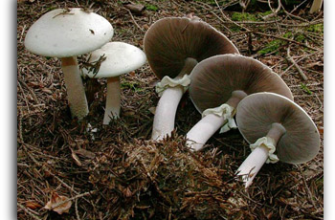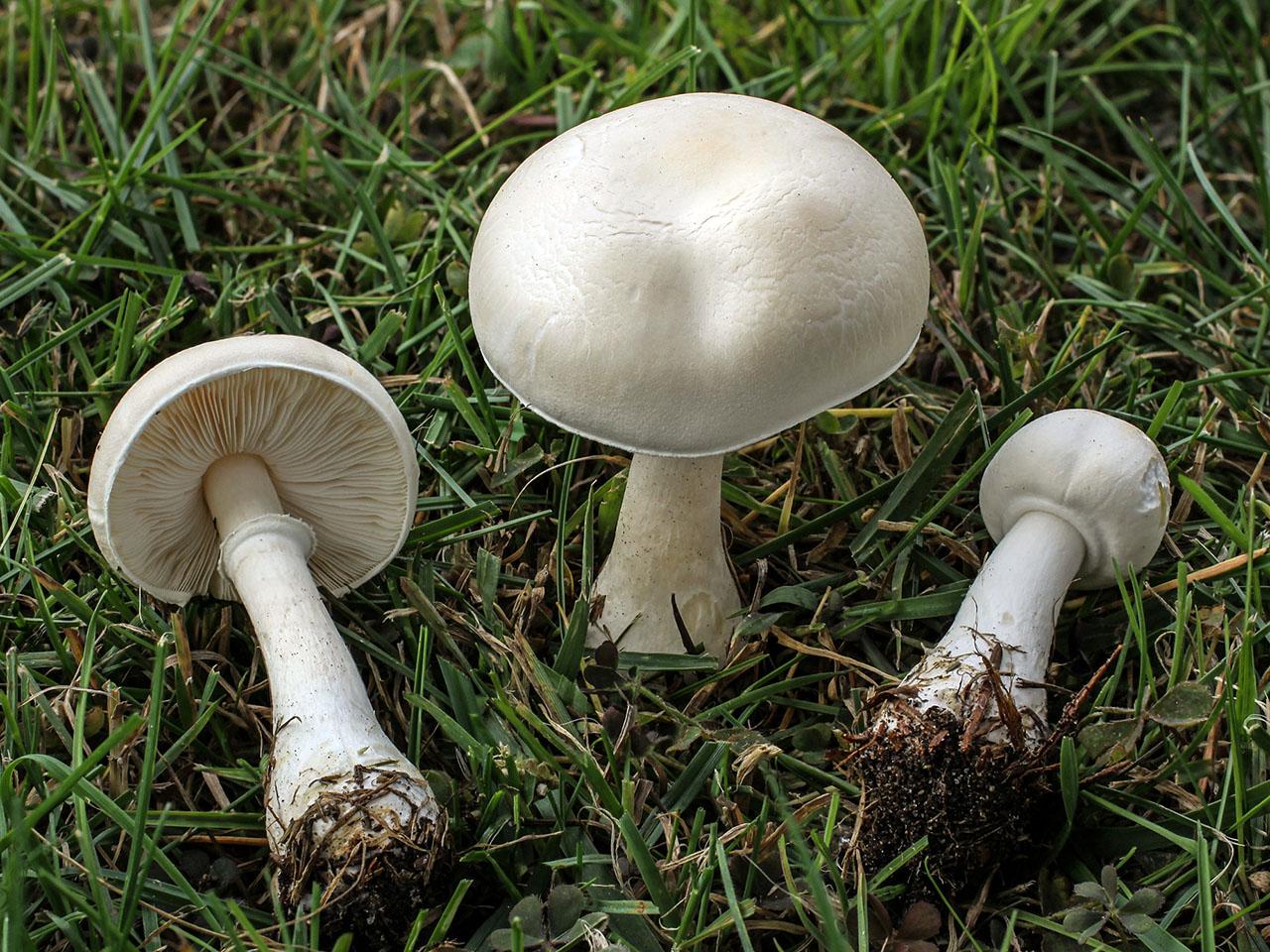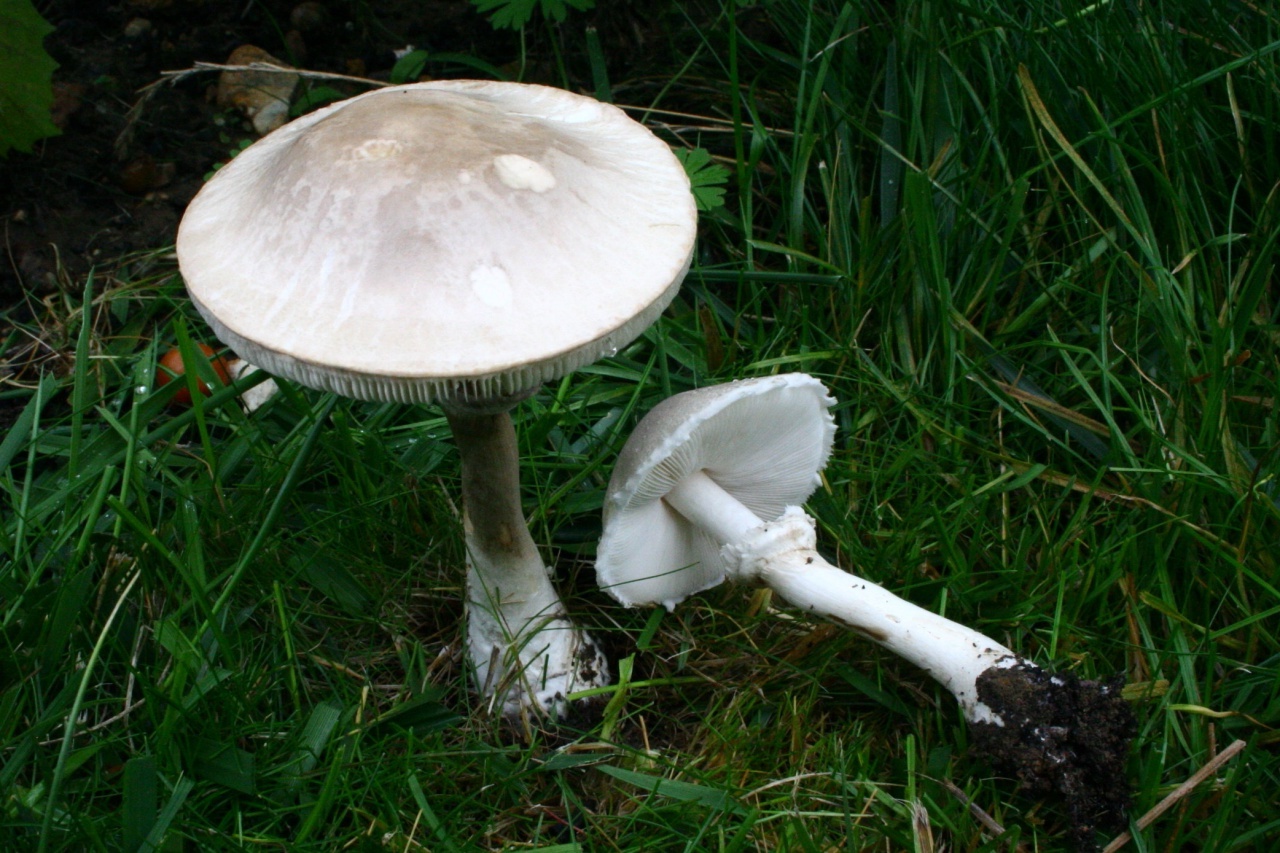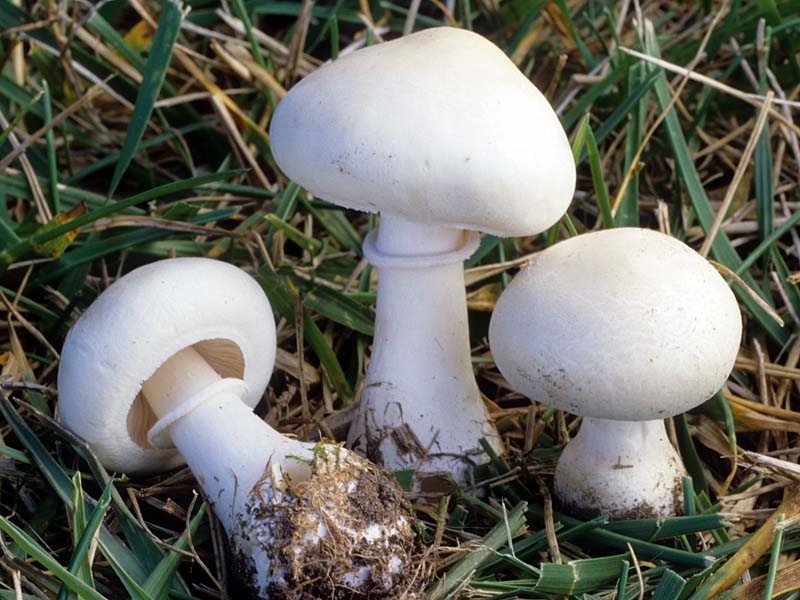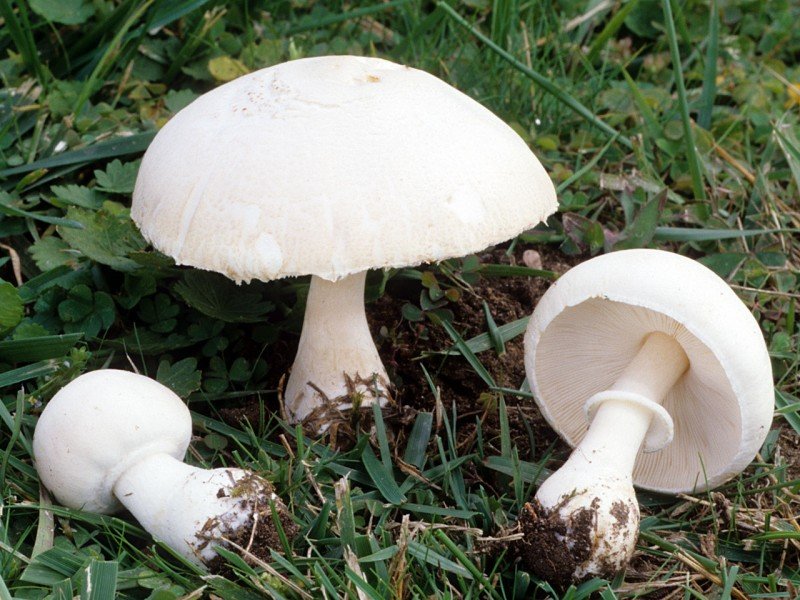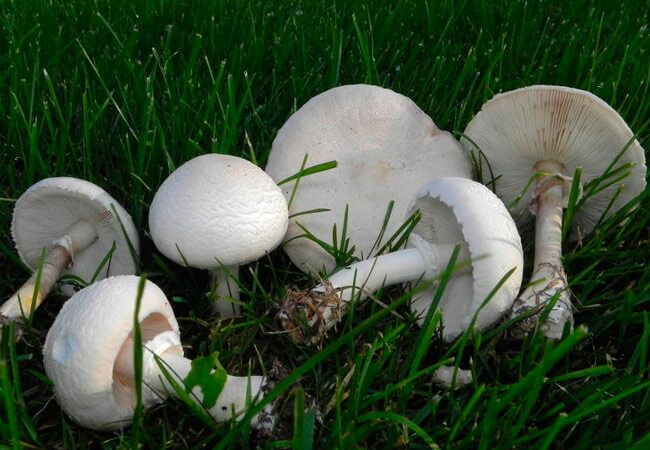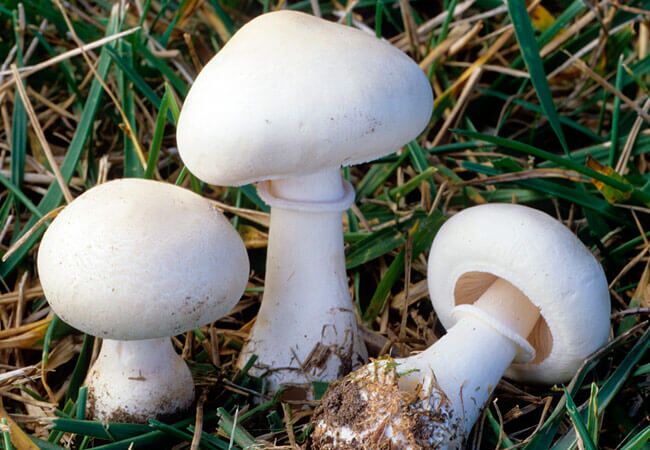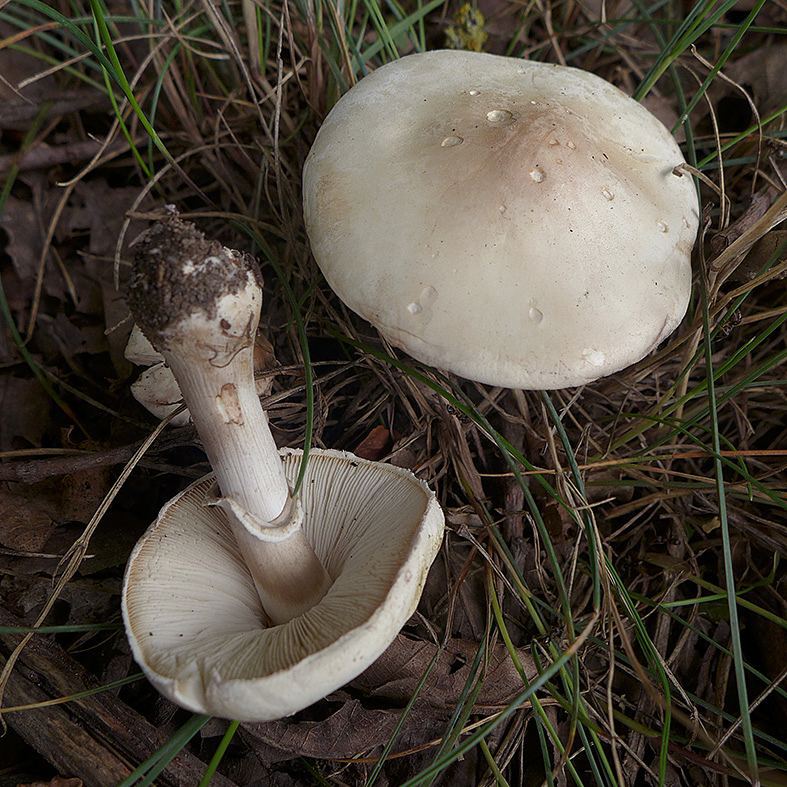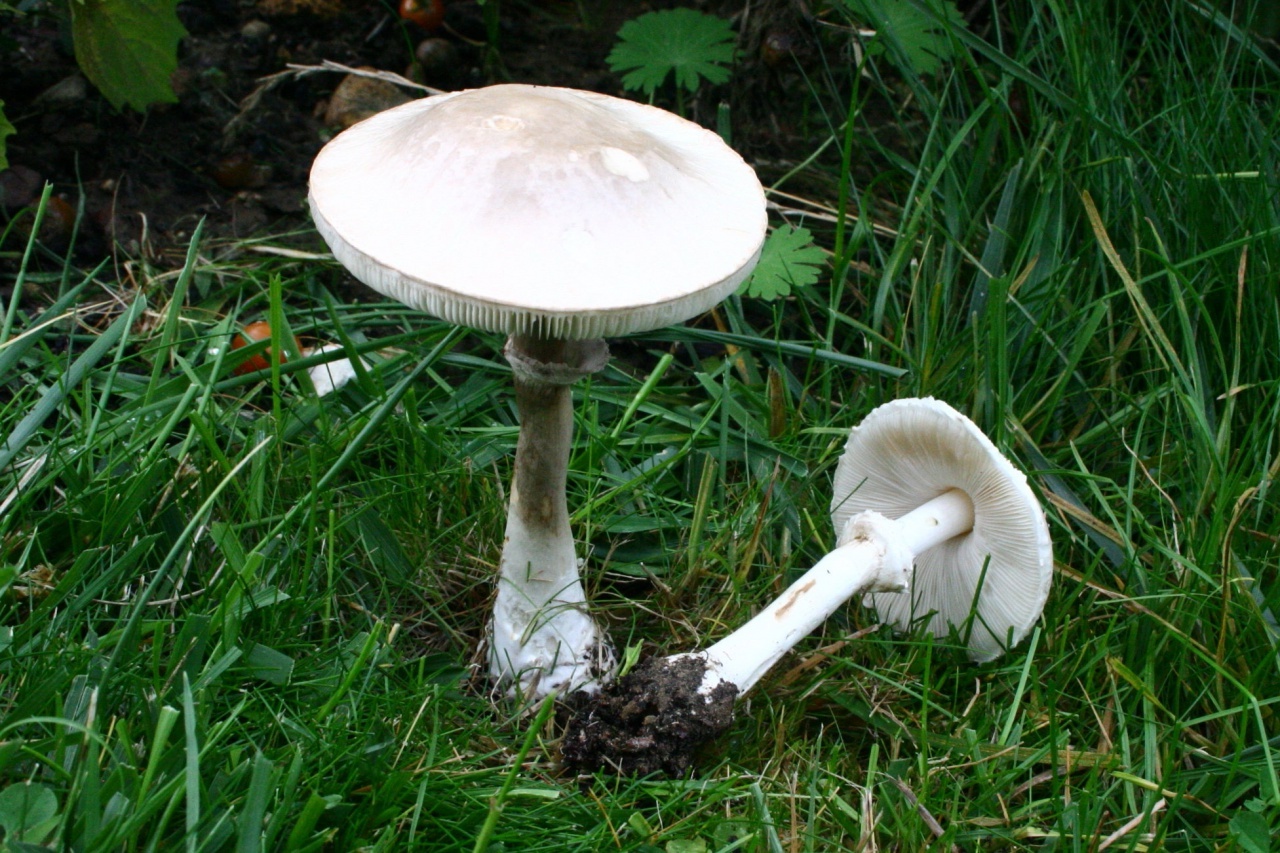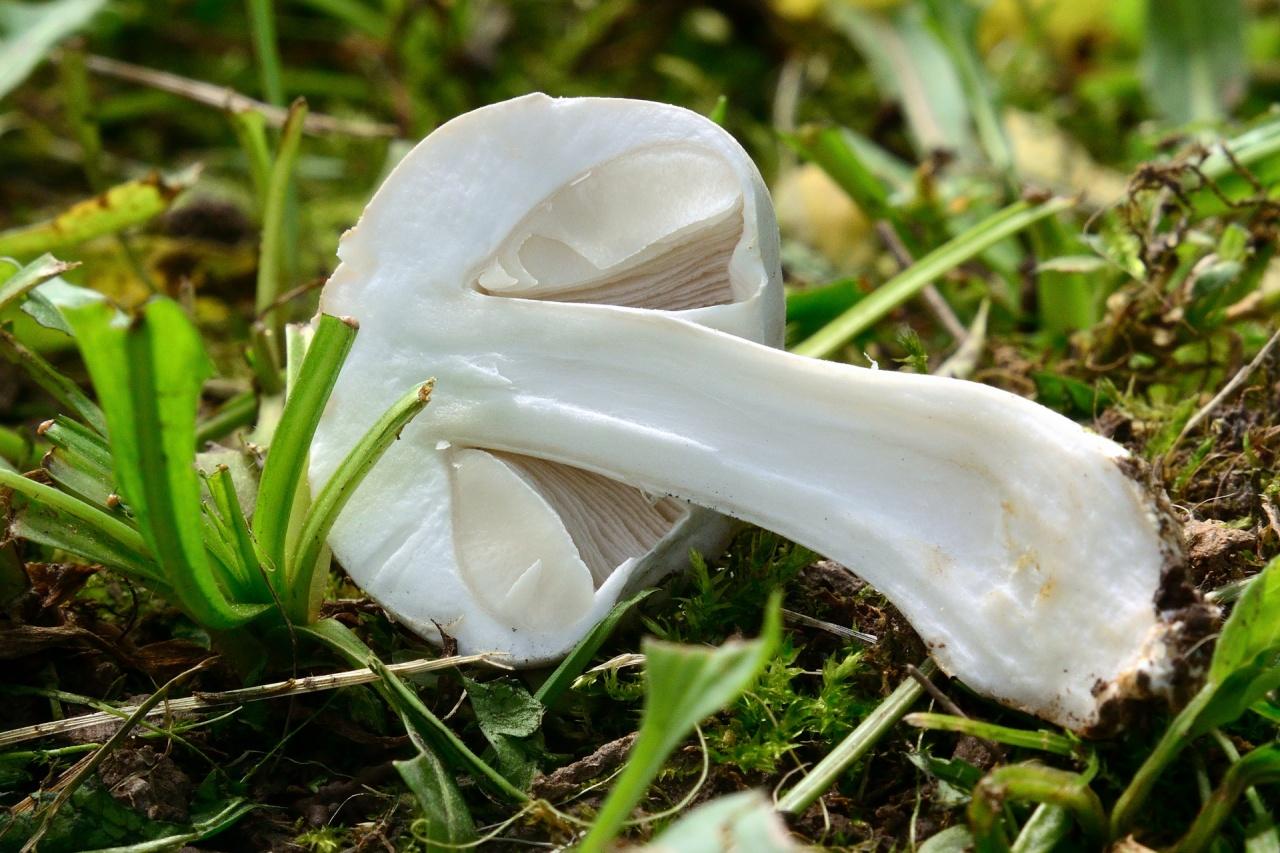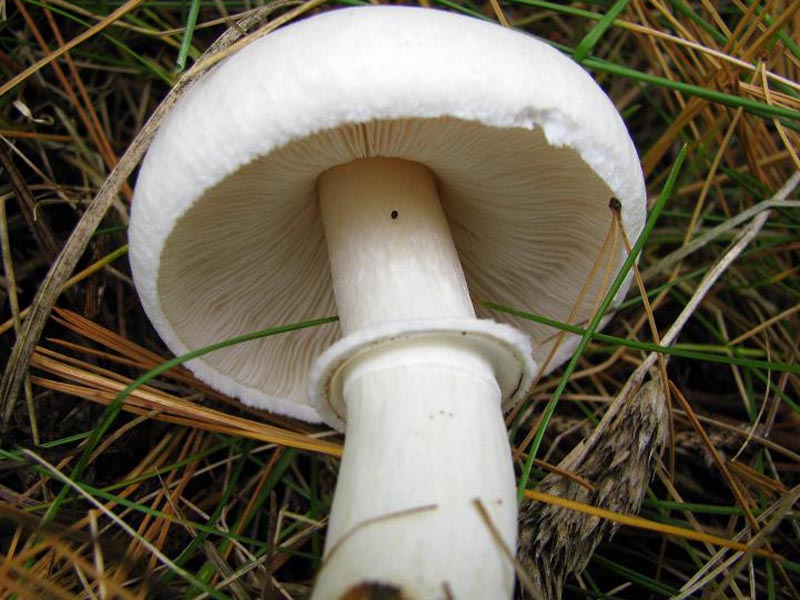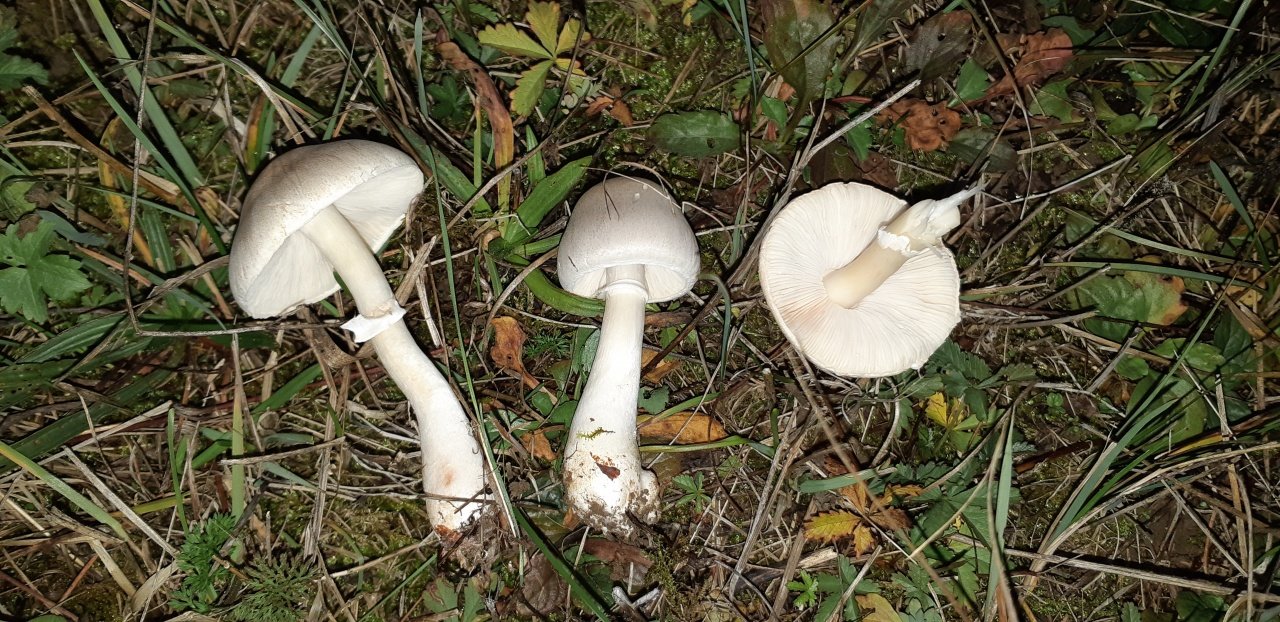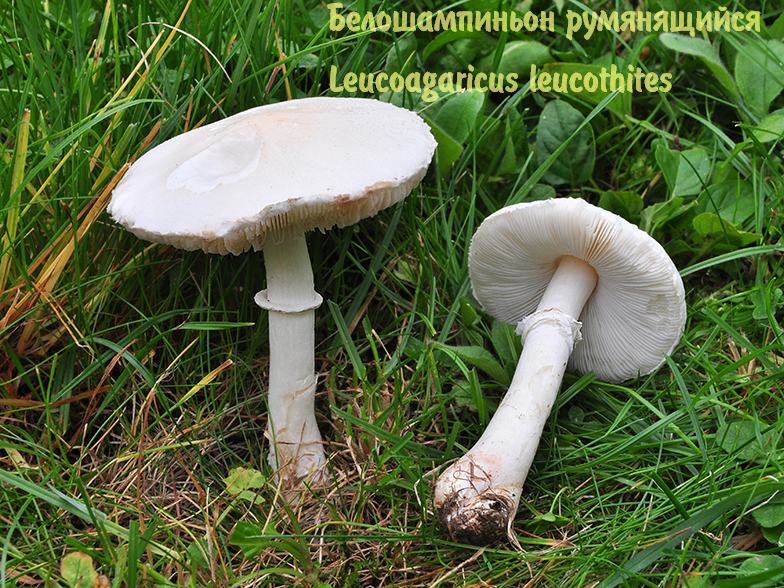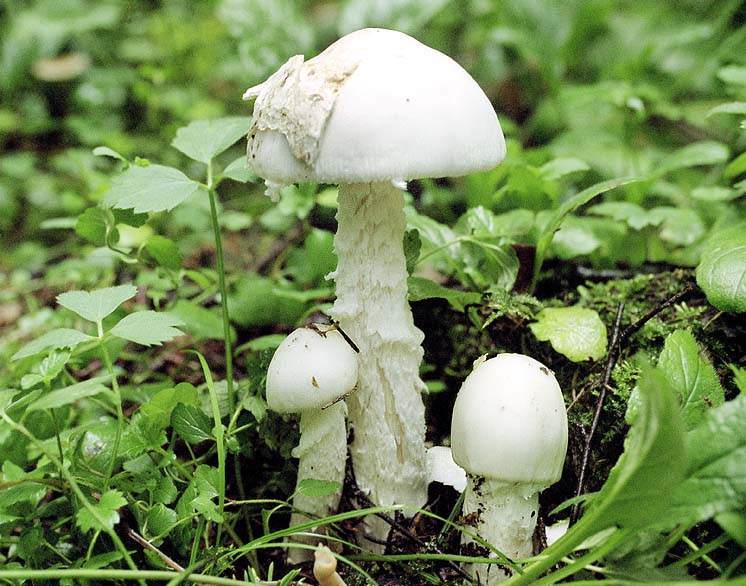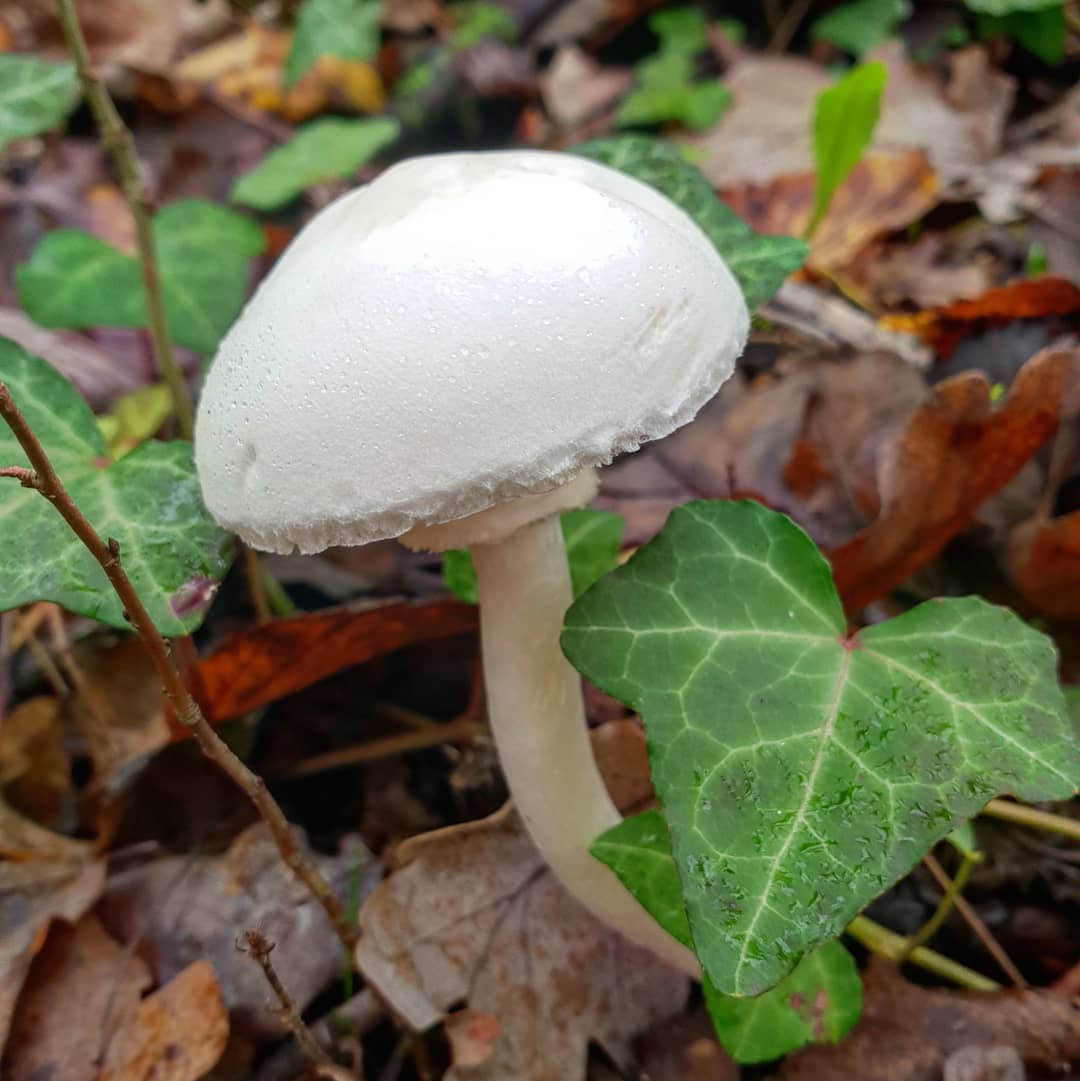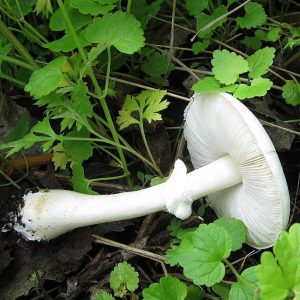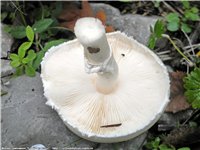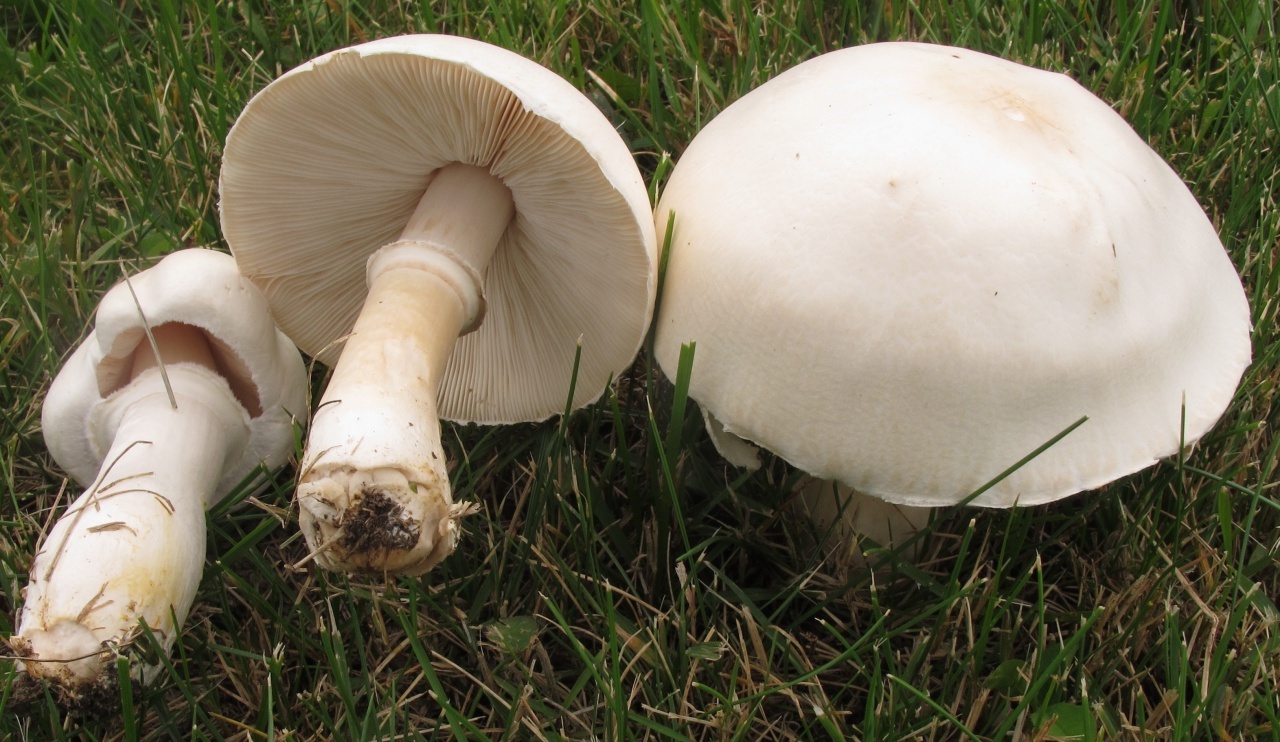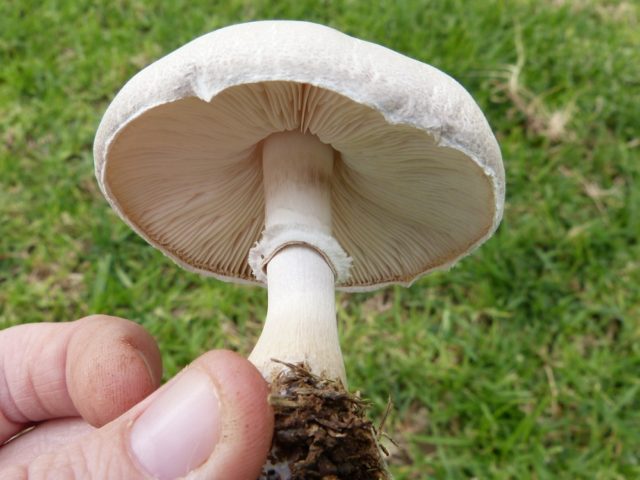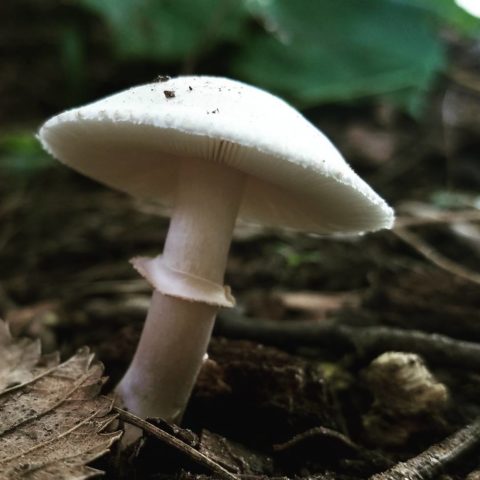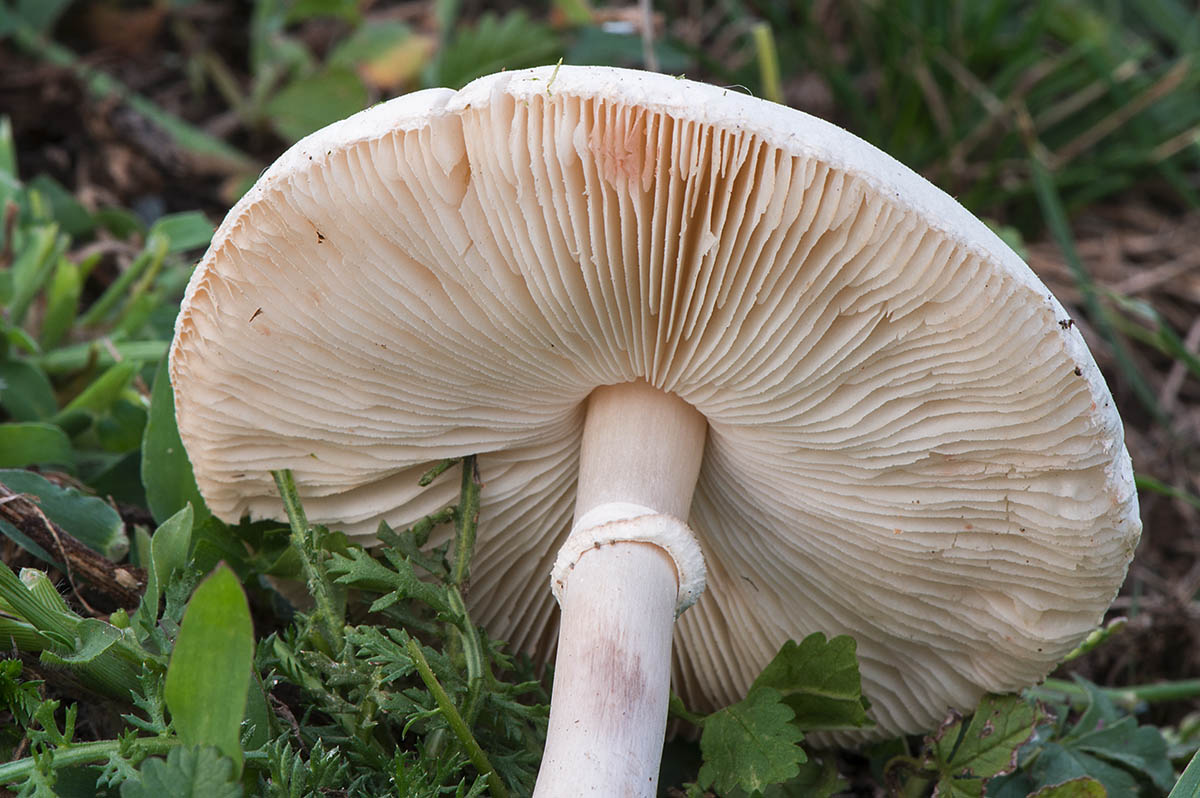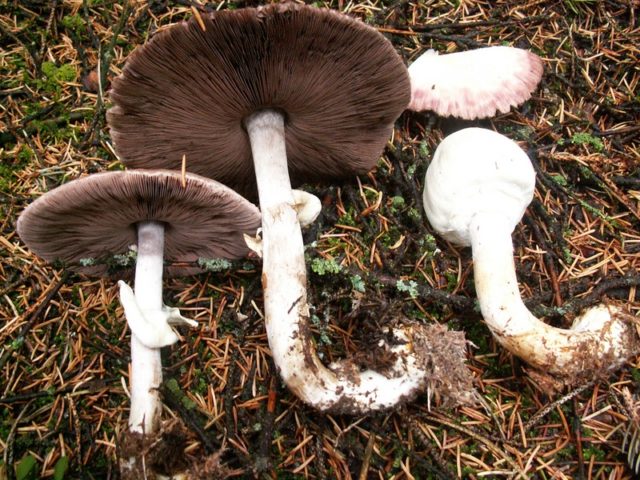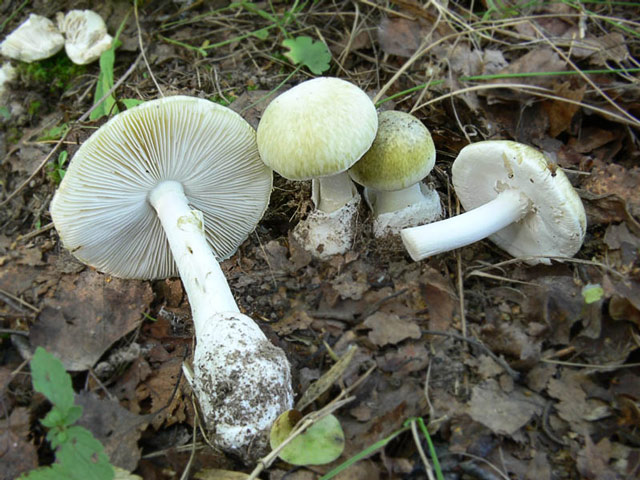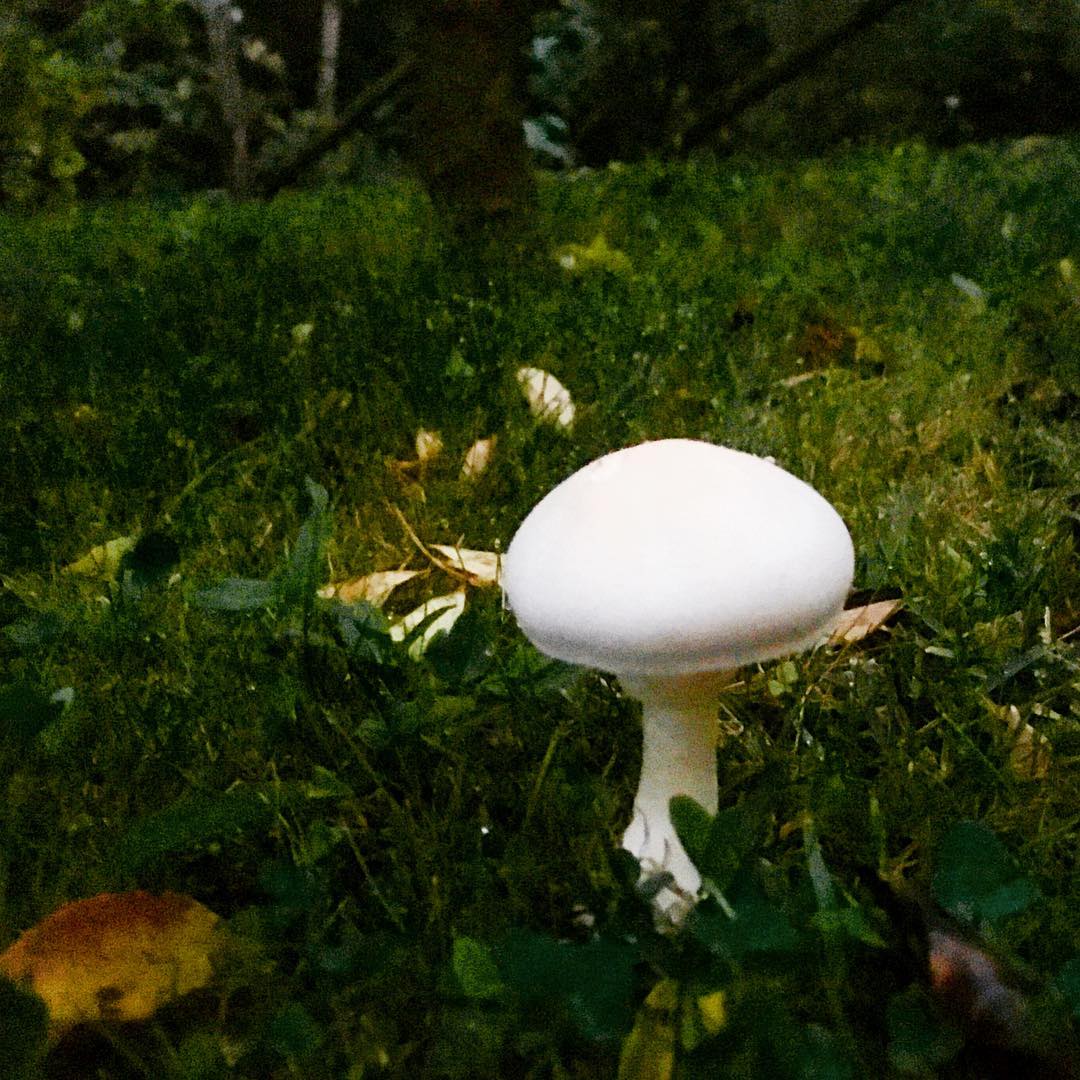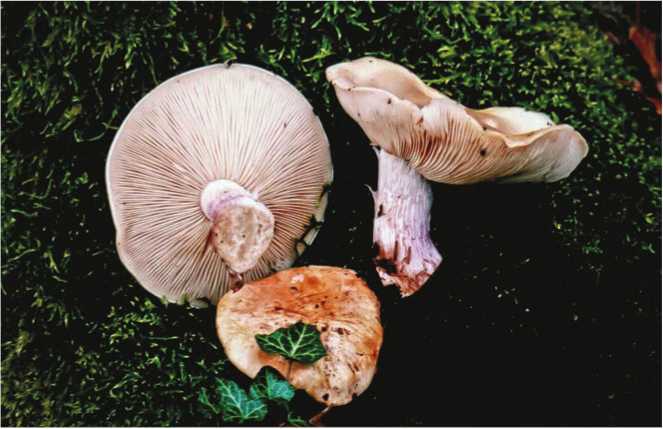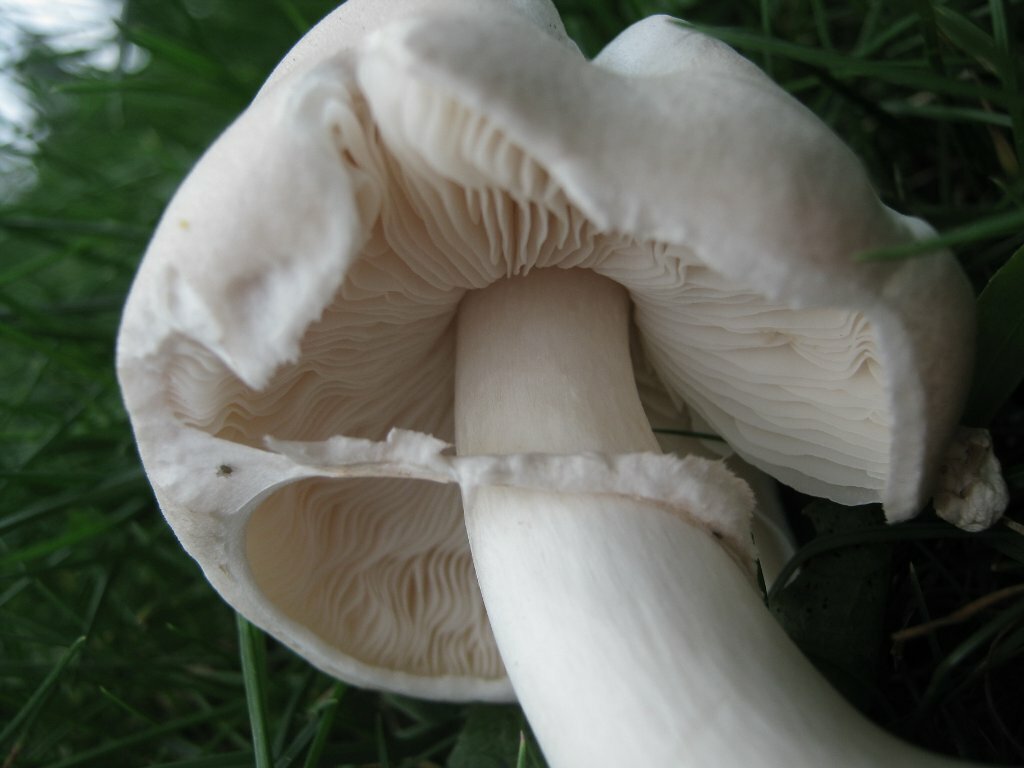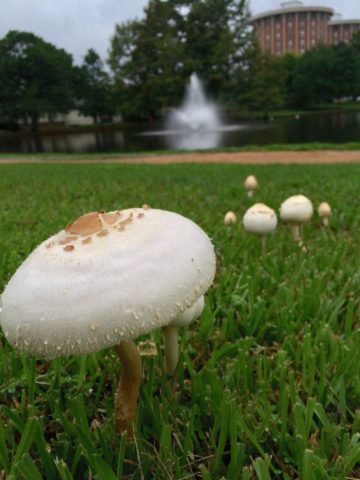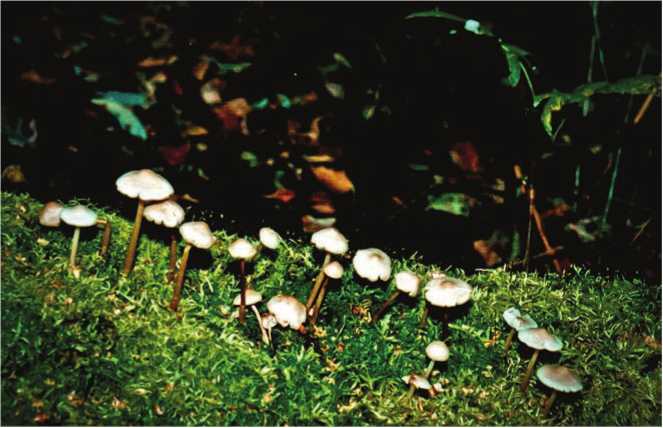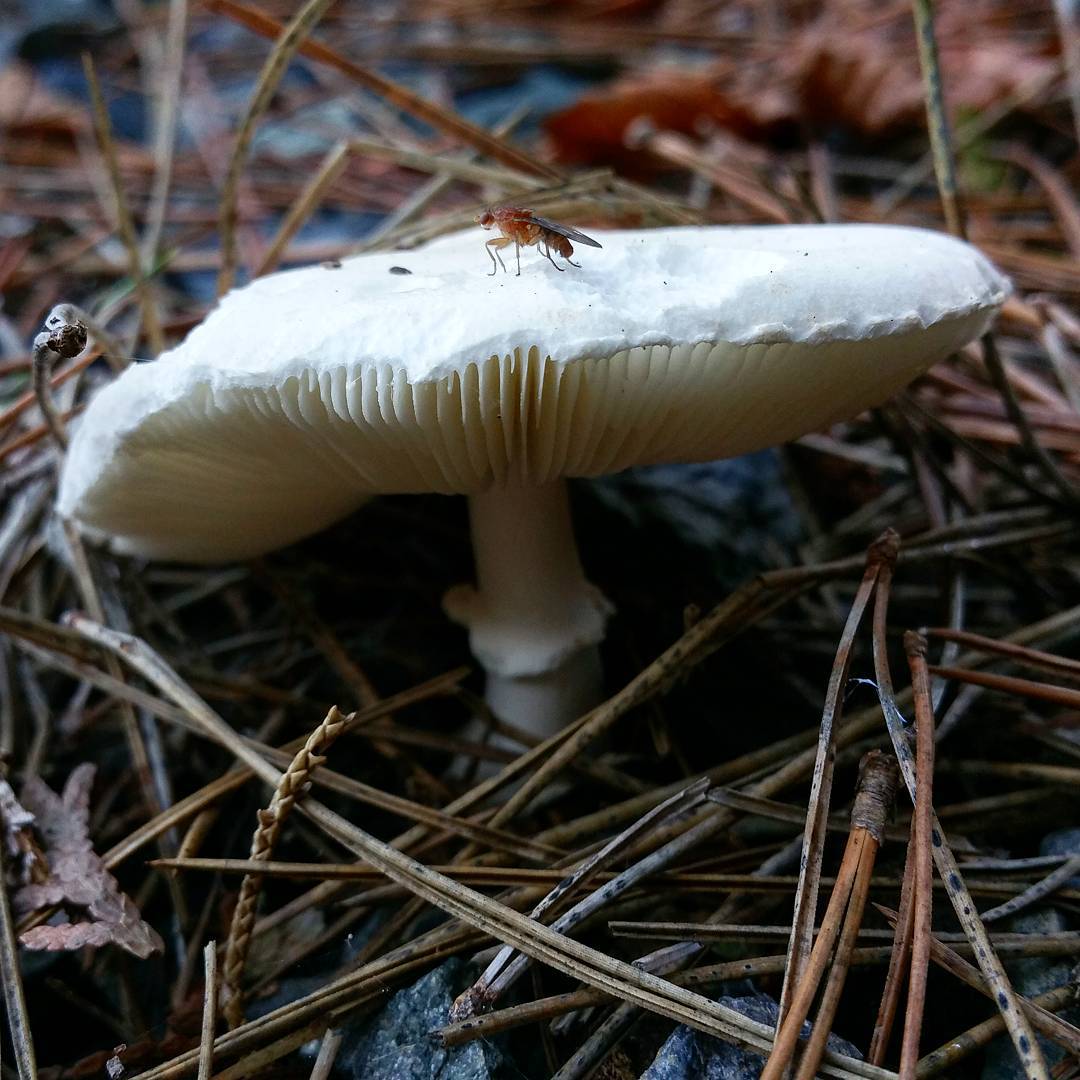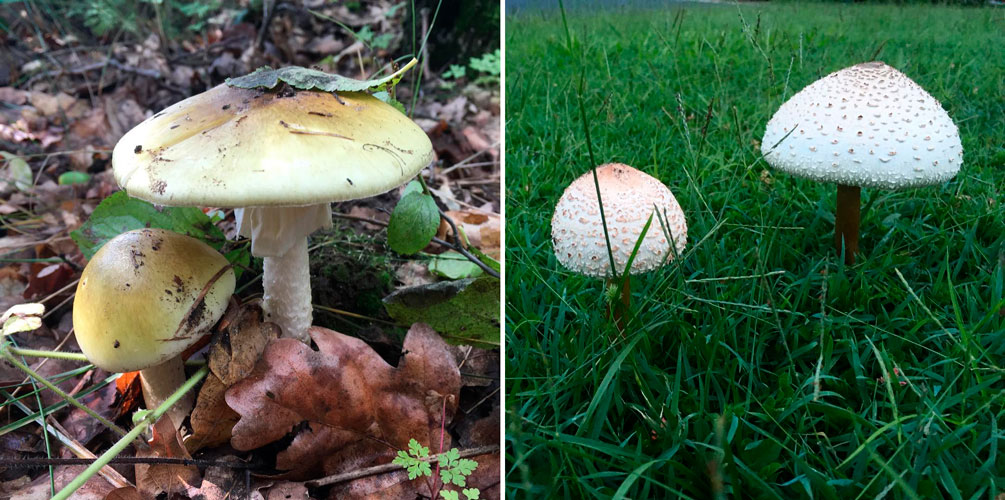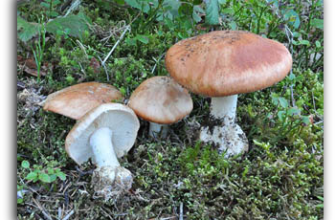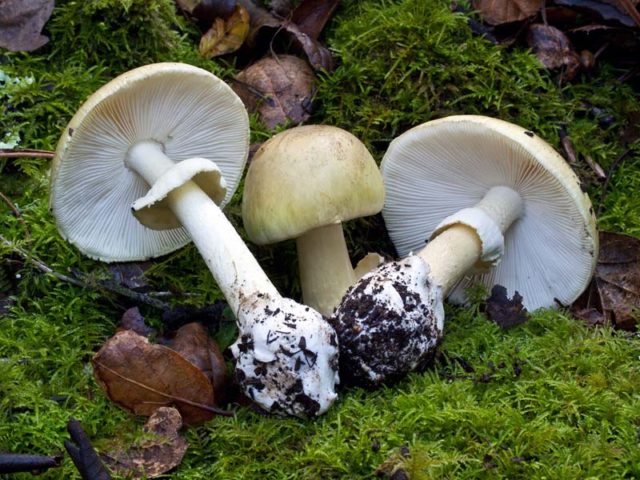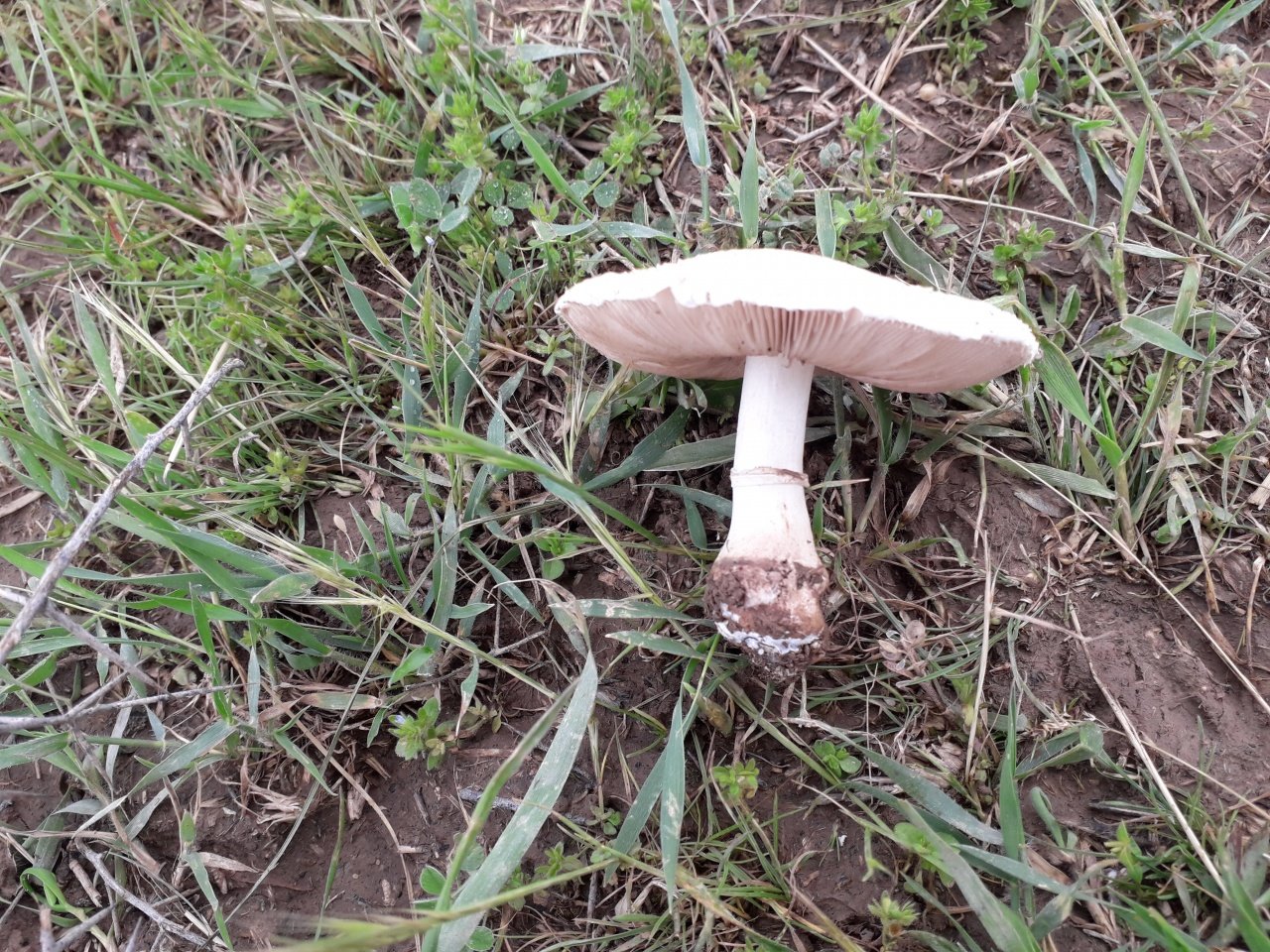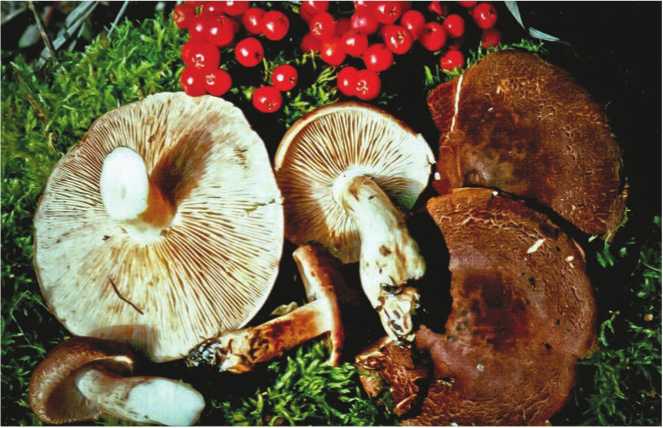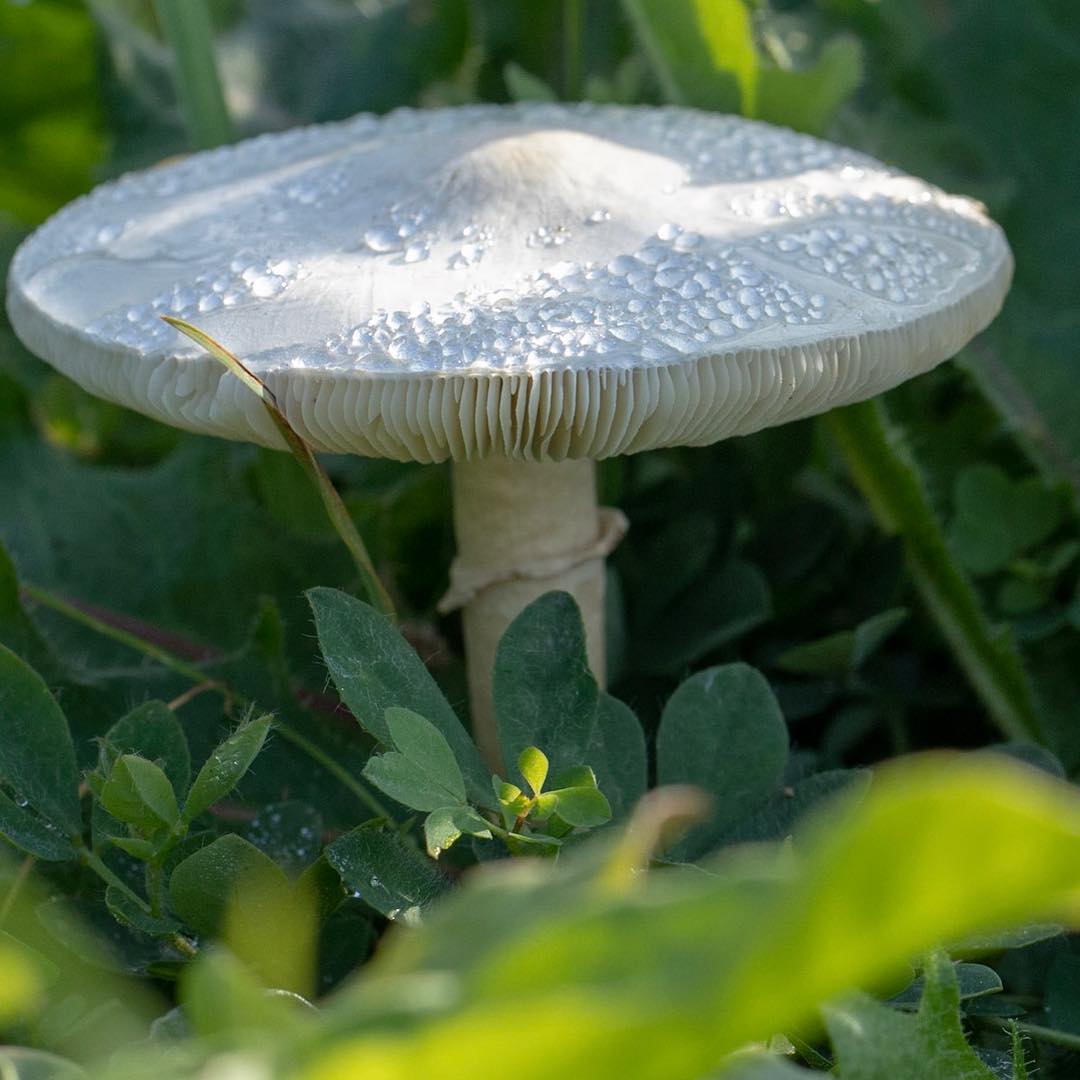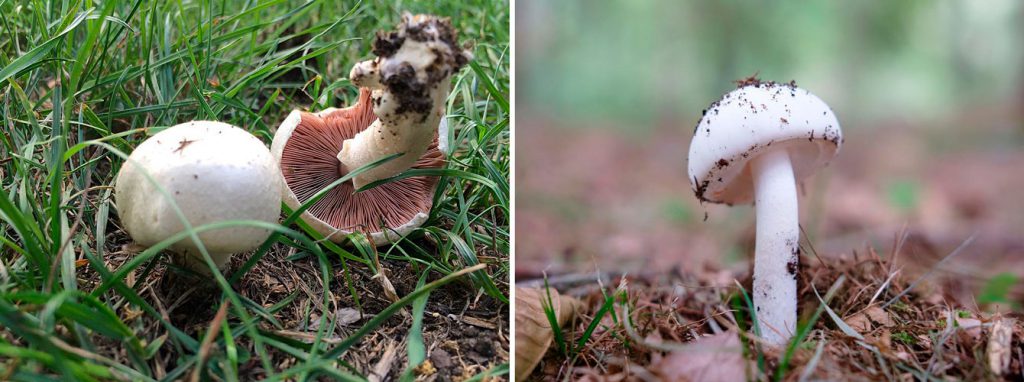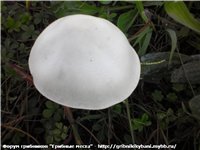Growing places
The growing area of long-rooted white champignon affects almost all corners of the planet. They are familiar with him in Eurasia, in America, in the Caucasus and even in Australia. However, it is so rare that in many countries it was included in the Red Book. For example, on the territory of Russia, this species can be found only in the Rostov region.
These mushrooms grow in soil rich in organic matter. That is why they are usually found near settlements: in cultivated areas, in parks, vegetable gardens, in pastures and arable lands.
White mushrooms begin to bear fruit as early as June and grow until October. They grow both singly and in small groups.
Difference from other species
Inexperienced mushroom pickers are advised to go on a quiet hunt with a more experienced companion, because there are many dangerous doubles that look very similar to champignons.
False, inedible mushrooms
Most often, inedible species live in forest areas, but can be found in gardens, parks and meadows. Outwardly, inedible fruits are very similar to champignons, but they have distinctive features. When pressed on the fruit body, the twins immediately turn yellow, and the cut at the base acquires a bright yellow color, which gradually turns into orange or brown. Edibles smell pleasantly of anise, and their counterparts have a "pharmacy" smell of iodine or carbolic acid.
The following types are of great danger to human health:
- redhead (A. xanthoderma);
The most accurate way to determine the unsuitability of a mushroom is heat treatment. Mushrooms, placed in boiling water, turn bright yellow for a few seconds along with water. When it boils, the unpleasant smell of drugs intensifies, but only for a couple of seconds. These fruiting bodies should not be eaten, because toxic substances do not disappear after boiling.
Mushrooms similar to champignons with white plates
In addition to close relatives, the mushroom can be confused with other similar mushrooms. Young edible fruits are very similar to pale toadstool and light-colored amanita species.
Amanita muscaria
These poisonous species with white plates live in coniferous and mixed forests, so they can be mistaken for coppice champignon. Its appearance practically does not differ from poisonous mushrooms: there are scales on the surface of the cap, the shape of the caps is the same, the white color of the plates and the presence of a ring on the leg.
Death cap
As you know, with age, the champignon changes the color of the plates, and the plates of toadstools and fly agarics remain snow-white all the time. When pressed, the poisonous fruit does not turn yellow, and its leg always grows from a volva, which is not always clearly visible.
Recipes and cooking rules
Champignon is such a common mushroom that there are many recipes with its addition. Let's consider the most universal ones.
Treatment
After picking or purchasing mushrooms, they should be processed before cooking. For this:
- washed under running water;
- wipe with a damp cloth;
- remove the top layer of the skin from the cap;
- if the cut on the leg is old, then it should be updated;
- skirts and dark plates are removed;
- places of damage are cut off.
Mushroom washing
It is not necessary to clean the caps. This procedure is done only for large mushrooms, because their skin becomes rough. If the skin is easy to move with your fingers, then it is better to remove the top layer.
Time and methods of cooking
Store mushrooms should be boiled for only five minutes, but wild mushrooms should be boiled for 10 minutes. If there is a multicooker, then you can cook them without adding water by setting the "Stew" program for 40 minutes.The frozen product is thawed and then boiled for 10 minutes.
Brewing process
For a salad, cook them for 5 minutes with the addition of salt, black allspice, bay leaf and citric acid. If the fruits are to be used for making soup, then boil them in slightly salted water for the same time.
How to fry mushrooms
For frying, fruit bodies do not need to be boiled beforehand. To fry them properly, you should:
- heat the pan well over medium heat;
- pour a little vegetable or butter;
- put the chopped mushrooms in a container in small portions and fry, stirring regularly;
- at the end of frying season with salt and pepper to taste.
Fried mushrooms
The browning time should not exceed 7 minutes. You can use the mushroom mass as an independent snack or include it in a wide variety of dishes.
Belochampignon ruddy (Leucoagaricus leucothites)
Edible mushrooms
Belochampignon ruddy (lat.Leucoagaricus leucothites) - a mushroom of the Champignon family, also known as an umbrella nut, or nut lepiota, is considered high quality, but it is recommended for collection only by the most experienced mushroom pickers, since this mushroom is easily confused with poisonous ones. The name of the mushroom contains the word "ruddy", this is due to the fact that when dry, the cap becomes "ruddy", widespread. Belochampignon meets in deciduous mixed forests and outside the forest, in forest glades and forest edges, in meadows, in fields, steppes, forest belts and in pastures, ruddy white champignons prefer open, well-lit areas, these mushrooms can also be found in vegetable gardens, gardens, parks and on roadsides, because the main habitat is grass. These are soil saprophages, they feed on the dead remains of animals and plants. You can find it almost throughout the season, starting from early July to mid-September... They grow in small groups of 2-3 fruiting bodies, they can also settle singly. The peak of fruiting occurs at the end of August.
Belochampignon ruddy is a little-known edible mushroom. It has a pleasant aroma and taste. Experienced mushroom pickers collect and use these mushrooms for food. It can be eaten both raw, added to salads and side dishes, and after heat treatment, fried or boiled. Also, these mushrooms can be dried or pickled. When dried, the white champignon caps acquire a pleasant pink color.
Belochampignon has an intermediate place between the genera Belonavoznik and Macrolepiota, which includes the main species of umbrella mushrooms. White champignons differ from Macrolepiot in the size of the spores and in the fact that they have rings on the legs, and from Belonavoznikov - in the surface of the cap.
The diameter of the ruddy beetle mushroom cap is 5-10 centimeters. Most often, the cap is thick-fleshed, but specimens with thin-fleshy hats can rarely come across. The cap is slightly convex, with a small tubercle in the middle. Over time, they become straighter, and torn remnants of films hang along the edges. The color of the cap is whitish, and its center is light cream. The surface of the cap is matte, smooth, like suede. As the mushroom matures, the skin cracks, and beige-gray scales form in the center. The cap is bell-shaped, then convexly outstretched, whitish, sometimes yellowish in the center, smooth, matte.
Belochampignon is outwardly similar to ordinary champignon, but its plates are lighter, and the spore powder is white. The pulp is firm, dense, white in color, with a pleasant mushroom smell. At the break, the color of the pulp does not change. The plates are even, often spaced, free. In young mushrooms, the plates are white, but darken as they age. The spores are up to 10 microns long, their color is white or slightly pink, they are smooth, ovoid. Spore powder of cream or white color.
The leg height is 5-10 centimeters.The stem is smooth, whitish in color, and in some specimens it may be grayish. The leg is curved, cylindrical. Young mushrooms have a white or brown ring on the stem. At the base, the leg is thicker, it passes into a root underground outgrowth. The pulp of the leg is fibrous. The pulp is white, with a pleasant mushroom smell.
It is not recommended for beginners to collect ruddy white champignons, as they can easily be confused with similar poisonous mushrooms, especially with fly agaric. You can confuse a mushroom with a white-colored champignon, but there is nothing wrong with that, both types are edible. The shape of the ruddy white champignon resembles a fly agaric, and it can be recognized due to the thickening of the leg and the ring under the cap.
Blush beetle mushroom can be confused with a deadly poisonous fly agaric, such as: Amanita virosa, as well as white mushroom (Amanita verna), Amanita mushroom (Amanita ovo> White mushroom Leuccooth)
Belochampignon red-lamellar
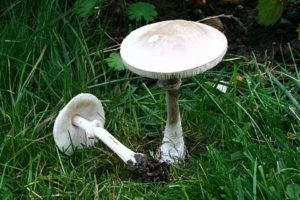
Belochampignon red-lamellar
This delicate, white-pink mushroom of the Champignon family is very beautiful. Belochampignon red-lamellar is very similar to an umbrella, and in the process of aging it darkens slightly with spots, which is why the people called it the Blushing Umbrella. This mushroom is very valuable among collectors, because it has an original nutty aroma and a pleasant rich taste.
However, this trophy of a quiet hunt has dangerous poisonous imitators. Therefore, you need to be able to distinguish between these mushrooms.
Red-lamellar white champignon, Leucoagaricus leucothites
Belochampignon red-lamellar - (lat.) Leucoagaricus leucothites
- The umbrella is ruddy;
- Nut lepiota;
- Lepiota is red-lamellar;
- Belochampignon nut;
- Lepiota naucina.
Hat
Small red-lamellar white mushrooms are very beautiful pure white. Their cap has a regular hemispherical shape, the edges are bent inward. And thanks to the veil covering the hymenial layer, the cap seems spherical at all.
But as they mature and grow, the mushrooms acquire a pink hue, very delicate. The cap also changes its shape - it looks like a half-open umbrella with small tubercles in the center. At the same time, by the time of fruiting, the private veil breaks, leaving felt flakes along the edge of the cap, and a ring on the leg.
Old mushrooms may even have an open, saucer-shaped hat with upturned edges.
The cap of the white champignon is rather large, fleshy: from 4 to 10 cm in diameter and about 1 cm thick. Its flesh is dense, and the surface of the cap is smooth, delicate, slightly velvety, matte. Mature mushrooms may have a skin cracking effect.
The hymenophore of these mushrooms is lamellar, white with a slight pink tint in the color of the cap itself. The plates are frequent and rather wide. The spore-bearing powder is pink, from which the hymenial layer itself acquires a characteristic tone.
Leg
The red-lamellar white champignon has a very graceful long leg, which reaches a length of 10 cm. Above, its diameter is about 1-1.5 cm, but towards the bottom it expands noticeably, which gives it the shape of a club. The leg itself is white, but the felt tight-fitting scales of a darker tone covering it give it a grayish tint.
At some distance from the cap on the peduncle, young specimens have a residual ring from a torn private veil, which later disappears.
The structure of the stem is hollow, and its flesh is dense, fibrous, white or slightly creamy and does not change color when cut.
Belochampignon red-lamellar - (lat.) Leucoagaricus leucothites
Place of growth
Red-lamellar white champignon has a rather long fruiting period. This mushroom grows all summer and most of autumn. It prefers enriched soils, so it can often be found in parks and gardens, meadows and fields, arable land and pastures, roadsides and lawns. Grass is a favorite habitat for this species.
They usually grow in small groups of 2-3 pieces, or even one at a time.
This mushroom can rightfully be called cosmopolitan, because it noted its presence in almost every corner of our planet, regardless of climate. Except perhaps the Arctic latitudes.
Edibility
Red-lamellar white champignon belongs to edible mushrooms. It is willingly collected by mushroom pickers, because this forest trophy is really very tasty. The pulp itself has a subtle fruity-nutty aroma. Some gourmets claim that the mushroom exudes a smell similar to chicken meat and has a pronounced mushroom taste.
Such white mushrooms can be eaten fresh, for example, added to side dishes or salads, as well as subjected to various treatments: boil, fry, salt, pickle and dry. When dried, the color of the mushrooms turns pink.
Notes (edit)
- Singer R. Diagnoses fungorum novorum Agaricalium // Sydowia. - 1948. - No. 2. - P. 26-42.
- Moser M. Die Röhrlinge und Blätterpilze (Agaricales). - 3. Aufl. (Kleine Kryptogamenflora Begründet von H. Gams). — Jena: Fischer, 1967. — Bd. 2b. T2. 443 S.
- Singer R. The Agaricales in modern taxonomy. - Vaduz: Cramer, 1975.
- Singer R. The Agaricales in modern taxonomy. - Koenigstein: Koeltz Sci. Books, 1986.
- Mushrooms: Handbook / Per. with ital. F. Dvin. - M.: "Astrel", "AST", 2001. - S. 65. - ISBN 5-17-009961-4.
- Wasser describes L. leucothites and L. holosericeus as different species; according to online databases L. holosericeus - synonym.
Let's go to rest together
If you are going to go to rest in these places for mushrooms or fishing or just sunbathe, then invite like-minded people to your company, it is more interesting to relax together.
All posted ads can be viewed in the Travel Book
Alekseevsky forest
A small group of friends | Going to a famous place looking for a company | There are places in the car | We are going to the woods for Alekseevka, today. To see what there is now from the mushrooms, we will stop by the Silver Spring. Join whoever wishes.
Other offers:
Volga under the Marx
Places on Bolshoi Karaman
The mouth of the Ternovka river and ponds
Lake Golden Bottom
Pond Wide brook
Former sand quarry
Free fishing spots in the Volga region of the Saratov region
Lake near the former Eaglet
Pond Liflyandsky and Plembazovsky
Tourist Saratov, 2018-2020. All rights reserved.
Where does the red-lamellar white champignon grow
Red-lamellar white champignon is widespread. It can be found in almost any climatic zone, excluding Antarctica. The fungus settles in mixed forests and outside the forest belt, prefers clearings, forest edges, pastures. Often grows along roads, parks, orchards and orchards. Belochampignon ruddy loves open, well-lit areas overgrown with dense grass.
The species is a soil saprotroph and takes nutrients from dead plant debris. The mycelium is located in the humus layer. In the course of its vital activity, the red-lamellar white champignon decomposes decaying organic matter into simpler compounds, improving the structure and chemical composition of forest soil.
Fruiting from mid-July to October. The peak of fruiting occurs at the end of summer. Grows singly and in small groups of 2-3 pcs.
Study history
The genus was first described in 1948 by R. Singer, who placed in it some of the species Lepiota s. l. and attributed it to the tribe Leucocoprinae Singer 1948, which he himself established, together with several morphologically similar genera (Belonavoznik (Leucocoprinus), Macrolepiota (Macrolepiota), Chlorophyllum (Chlorophyllum), Volvolepiota). Understanding the volume of labor Leucocoprinae there were disagreements between researchers, many species were transferred from one genus to another within this tribe, and sometimes within a family or order. With the advent and development of methods of molecular phylogenetics, the composition of genera is being actively revised. Until 1975, 6-18 species described at that time were attributed to the genus Belochampignon, by 1990 - up to 26 species. According to the 2008 Ainsworth and Bisbee Dictionary of Mushrooms, the genus contains about 90 species.
Types and their description with photo
Champignons grow in forests, fields and meadows, depending on this, experts distinguish several types of mushrooms that have certain differences.
Forest
Forest mushroom can often be found under another name - blagushka. The cap reaches 5-10 cm in diameter. The color is brown-pink, and the surface is covered with large brown scales. Due to the scales, the mushroom takes on a purple or purple hue. If you press on the pulp, it will first turn red and then turn brown. The taste and smell of the pulp is pleasant, mushroom. The light flesh turns red at the cut.
The leg is 5-10 cm long and about 1.5 cm thick.The fruit forms a cylindrical stem that often becomes curved. Young specimens have a solid leg, while in more mature ones it becomes hollow. The leg is whitish in color with small scales. The hanging ring is located closer to the cap.
Meadow
Meadow mushrooms are often called peppers or common mushrooms. The cap grows up to 15 cm in diameter. Young mushrooms form a spherical, then a hemispherical cap. When ripe, the cap becomes open and silky to the touch. The dry cap of old fruits is covered with small scales and acquires a brownish tint in the center.
The leg length is 3-10 cm. The cylindrical leg is solid and painted in the same color as the cap. Its base is often brownish in color. A thin ring is located closer to the middle of the leg. Often the ring disappears in mature fruiting bodies. The pulp is white, in places of the cut it acquires a pink tint.
Field
Field champignon is characterized by a silky white cap, the diameter of which varies from 5 to 15 cm. For a long period of time, the cap is closed and hemispherical. Ripe fruits have an open cap, which droops in old age. The sturdy leg is quite thick and white. A two-layer ring is formed on it, the lower part of which is broken in a ray-like manner.
The curved plates are off-white at the beginning of growth, and in mature mushrooms they become brown and loose. The white flesh on the break turns yellow and smells like anise.
Rules and places of collection
It is better not to cut the mushroom, but to twist it out of the soil. The cut site may begin to rot, which is fraught with the death of the entire mycelium.
You can find meadow mushrooms in open areas, the soil of which is rich in humus. After the rains, they are found near farms, in meadows, pastures, in gardens, parks and vegetable gardens. Sometimes mushrooms are found on forest edges, where they usually grow in groups. It happens that the fruiting bodies form "witch's rings". The field mushroom can live in mountainous areas, near spruce trees and nettle thickets. Forest champignon most often forms mycorrhiza with spruce. He is also found near anthills.
The benefits and harms of champignons
If the fruits grew in good conditions and did not have time to absorb environmental toxins, then they can be consumed even by pregnant and lactating mothers.
The mushroom contains a lot of substances useful for humans:
- Minerals: manganese, magnesium, calcium, zinc, sodium, iron.
- Vitamins of group B, E, C, PP, D.
- They contain protein that is easy to digest. Minerals, together with protein, accelerate metabolism, so this product is often included in various dietary meals.
In addition, the product is also consumed raw - in appetizers and salads. During cooking, some of the nutrients disappear, but excellent taste is revealed.
Views
List on the site "Encyclopedia of Life" and other sources:
- Leucoagaricus amanitoides R.M. Davis & Vellinga, 2006
- Leucoagaricus americanus (Peck) Vellinga, 2000
- Leucoagaricus barssii (Zeller) Vellinga, 2000
- Leucoagaricus brunneocingulatus (P.D. Orton) Bon, 1976
- Leucoagaricus carneifolius (Gillet) Wasser, 1977 - Body-lamellar white champignon
- Leucoagaricus cinerascens (Quél.) Bon & Boiffard, 1978 - Belochampignon gray, or smoky
- Leucoagaricus croceovelutinus Bon, 1976
- Leucoagaricus crystallifer Vellinga, 2000
- Leucoagaricus crystalliferoides T.K.A. Kumar & Manim., 2009
- Leucoagaricus dacrytus Vellinga, 2010
- Leucoagaricus georginae (W.G. Sm.) Candusso, 1990
- Leucoagaricus glabridiscus (Sundb.) Wuilb., 1986
- Leucoagaricus gongylophorus (Möller) Singer, 1986
- Leucoagaricus griseodiscus (Bon) Bon & Migl., 1991
- Leucoagaricus ionidicolor Bellù & Lanzoni, 1988
- Leucoagaricus irinellus Chalange, 1999
- Leucoagaricus leucothites (Vittad.) Wasser, 1977 - Belochampignon ruddy, or nut umbrella
- Leucoagaricus marriagei (D.A. Reid) Bon, 1976
- Leucoagaricus medioflavoides Bon, 1976
- Leucoagaricus meleagris (Sowerby) Singer, 1952
- Leucoagaricus menieri (Sacc.) Singer, 1968
- Leucoagaricus moseri Wasser, 1978 - Moser Belochampignon
- Leucoagaricus nympharum (Kalchbr.) Bon, 1977
- Leucoagaricus pilatianus (Demoulin) Bon & Boiffard, 1976
- Leucoagaricus purpureolilacinus Huijsman, 1955
- Leucoagaricus serenus (Fr.) Bon & Boiffard, 1974
- Leucoagaricus sericifer (Locq.) Vellinga, 2000 - Silky white champignon
- Leucoagaricus subcretaceus Bon, 1981
- Leucoagaricus sublittoralis (Kühner ex Hora) Singer, 1969
- Leucoagaricus tener (P.D. Orton) Bon 1977
- Leucoagaricus viridiflavoides B.P. Akers & Angels, 2000
- Leucoagaricus wichanskyi (Pilát) Bon & Boiffard, 1974 - Vihansky Belochampignon
Species attributed by some authors to the genus Belochampignon and transferred to other genera:
- Leucoagaricus badhamii (Berk. & Broome) Singer, 1951 = Leucocoprinus badhamii (Berk. & Broome) M.M. Moser, 1943
- Leucoagaricus caldariorum (D.A. Reid) Bon, 1993 = Leucocoprinus caldariorum D.A. Reid, 1990
- Leucoagaricus cretaceus (Bull.) M.M. Moser, 1953 = Leucocoprinus cretaceus (Bull.) Locq., 1945
- Leucoagaricus excoriatus (Schaeff.) Singer, 1948 = Macrolepiota excoriata (Schaeff.) M.M. Moser, 1978 - White umbrella mushroom
- Leucoagaricus hortensis (Murrill) Pegler, 1983 = Chlorophyllum hortense (Murrill) Vellinga, 2002
- Leucoagaricus josserandii (Bon & Boiffard) Raithelh., 1989 = Lepiota subincarnata J.E. Lange, 1940
- Leucoagaricus medioflavus (Boud.) Bon, 1976 = Leucocoprinus medioflavus (Boud.) Bon, 1976
- Leucoagaricus medullatus (Fr.) Bon, 1977 = Lepiota medullata (Fr.) Quél., 1872
- Leucoagaricus pulverulentus (Huijsman) Bon, 1978 = Cystolepiota pulverulenta (Huijsman) Vellinga, 1992


